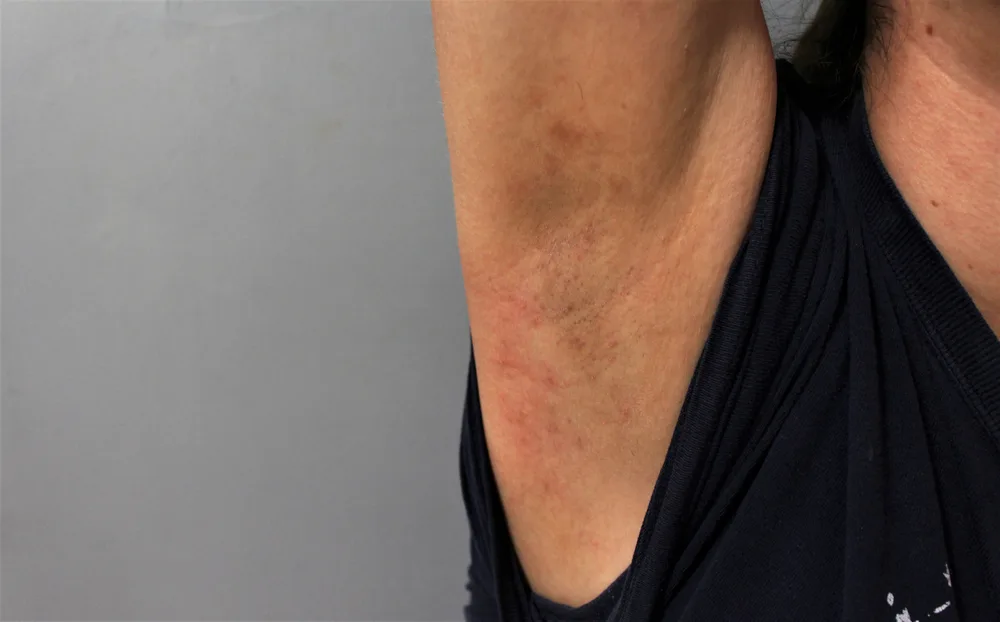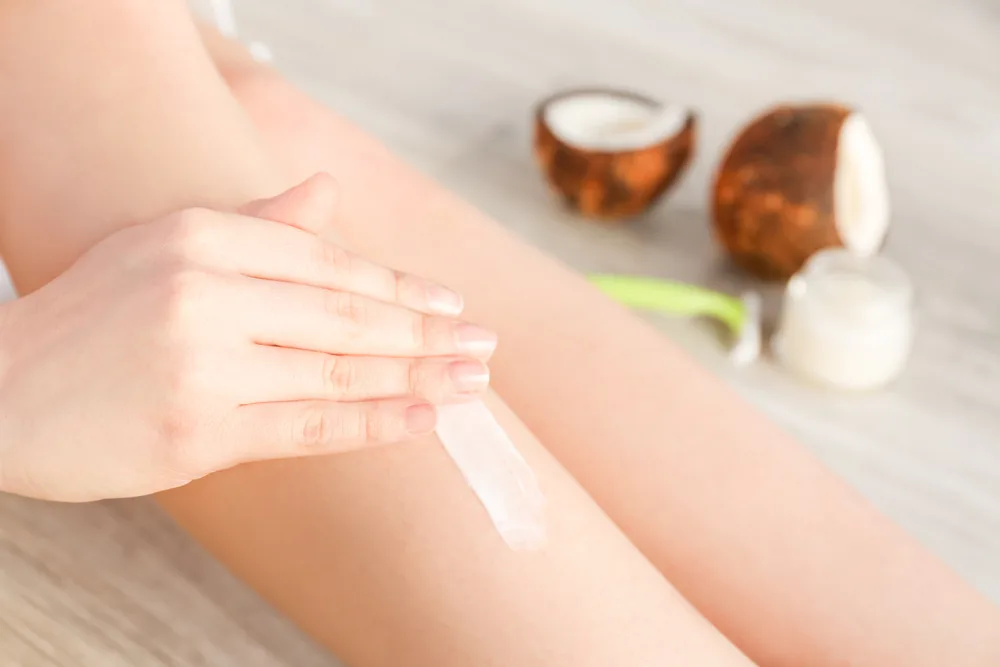Jump to:
Do you experience irritation and get razor bumps from using shaving cream? Or maybe you want to shave and discovered you ran out of shaving cream at midnight? Don’t panic! There are many alternatives to shaving cream.
You probably have several shaving cream substitutes in your shower with you right now. If you are looking to switch it up, become more eco-friendly, or want a solution when in a pinch, below are the best shaving cream substitutes.
14 Shaving Cream Subtitles to Use in a Pinch
Shaving cream is a product placed over hair that needs to be shaved off with a razor. The shaving cream helps the razor move smoothly over the area needing attention and protects the skin from nicks and razor burns. But while shaving cream is great, sometimes you have to improvise.
1. Bathing Liquid or Shower Gel
Most shower gels and bathing liquids are designed to keep your skin moisturized. They are filled with moisturizing ingredients to help you get clean but supple skin.
The blend of moisturizing and cleansing ingredients can work as a shaving cream substitute. Work your shower gel on the area you want to shave to a nice lather. Shave the hair and ensure you moisturize after showering to avoid irritation.
2. Soap
Moisturizing soaps work the same way as shower gels and bathing liquids. However, most soaps can be quite harsh and strip the skin of all moisture. I would not recommend using soap to shave large areas over a long period. If you can shave in a minute or two, then use soap in a pinch.
Otherwise, leaving the drying soap on your skin for fifteen to thirty minutes can irritate the area. After you shave with soap, follow with a moisturizer and seal with an oil to soothe the skin.
3. Hair Conditioner
My favorite in-shower substitute for shower gel is hair conditioner. Conditioner is designed to soften and smoothen hair follicles. It is moisturizing and the silky and creamy consistency allows for smooth gliding of your blade.
Apply the conditioner to the area you want to shave and gently massage it to form a layer. Shave, rinse and wash off the residue with soap and/or shower gel.
4. Aloe Vera Gel
This soothing, cooling and hydrating gel is perfect after shaving. Aloe vera gel reduces inflammation, soothes irritation, hydrates your skin, and cools it as well.
Because of this, you can also use it when shaving. Apply a nice layer of Aloe gel on your skin and use it as a shaving cream substitute for a smooth shave. You will also get no irritation in the days after shaving.
5. Lotion
Body lotion is a good shaving substitute in a pinch. However, I recommend it for shaving any area with little hair. Using body lotion on thick, coarse, or long hair will irritate your skin unless you apply a thick layer of it. Use body lotion as you would conditioner and cleanse the area afterward.
6. Baby Oil
Baby oil is made of mineral oil and well-formulated to be safe for a baby’s sensitive skin. The fragrance can cause tiny, inflamed bumps (contact dermatitis) in people with allergies and sensitivities to fragrance.
An alternative is unscented baby oil. This oil provides a nice protective film between your skin and the blade. It protects your skin from water loss.
7. Body Oil Blends
Any oil you find in the shop touted as body oil will also do the trick. They are made out of different oil blends like wheat germ oil, coconut oil, jojoba oil, and more. Some even have mineral oil.
These oils are made to lock in moisture on your skin, keeping it smooth, soft, and supple. You can use a generous amount on any area you wish to shave after showering and watch the blade glide smoothly over it.
8. Rosehip Oil
Rosehip seed oil is not just a great post-shave oil. It also works well as a shaving cream substitute, especially for the face. If you are prone to irritation, burning, and post-shave bumps, try using rosehip seed oil. It conditions and soothes the skin and can help fade scars and marks from razor bumps and ingrown hairs.
9. Jojoba Oil
Jojoba oil is often used as a pre-shave conditioner and an aftershave soother. This is because it is anti-inflammatory and mimics our skin’s natural oils. Because of this, you can use it to shave, especially on the face and sensitive areas. Simply spread a good amount on the area and shave.
10. Olive Oil
Olive oil is an amazing oil rich in vitamins like A, D, E, and K. It is also rich in antioxidants and fights bacteria, making it skin-friendly and soothing.
Olive oil is non-comedogenic which makes it perfect for people with oily skin or those prone to acne. Spread a thin layer over your skin and use it as a shaving oil.
11. Coconut Oil
Coconut oil is antibacterial, anti-inflammatory, and has a few anti-oxidant properties. It is an excellent sealing oil as it locks in all the moisture. You can use coconut oil as a shaving balm, especially for areas with thicker, coarser hair.
However, it is important to note that coconut oil can be comedogenic so avoid using it if prone to acne. Also, be sure to wash it off with soap after shaving.
12. Macadamia Oil
Macademia oil is one of nature’s best gifts. It is rich in omega-6 fatty acids, squalene, and oleic acid. It softens and moisturizes without clogging pores.
You can use macadamia oil to achieve a smooth shave and use it after shaving and cleansing for the softest skin. It doesn’t irritate and balances the skin’s sebum production making it great for sensitive, oily skin.
13. Vegetable Oil
Vegetable oil is a cheap and effective alternative to shaving cream. Most vegetable oils are very refined and do not irritate when used on the skin.
Application is messy so opt for a bottle with a nozzle to carefully apply the oil onto your skin. After shaving, thoroughly cleanse your skin with soap and moisturize.
14. Sunflower Oil
Sunflower oil is rich in linoleic acid and vitamin E. It prevents premature aging and wrinkles and helps retain a lot of moisture. This oil applies smoothly and gives a soft, protective layer when you shave. A little goes a long way when shaving.
Potential Risks And Side Effects of Shaving Cream Alternatives

Bluee77/Shutterstock
The items on this list are safe to use on the body. You are unlikely to get an adverse reaction if you are not allergic to the ingredients. With that said, there is always a risk when trying a new skincare product.
If you have not used any item before, stick to the alternatives you have used on your body. For people prone to acne and clogged pores, stay away from coconut oil and any body oil blend that has coconut oil.
Avoid baby oil, scented shower gels, and hair conditioners if you are sensitive to fragrance and prone to dermatitis. Opt for unscented versions or try other items on the list. Macadamia oil is not the ideal shaving cream substitute for those allergic to nuts.
To avoid any reactions, patch test any item on your skin and wait 24 to 48 hours to use it. If you must shave at that moment or simply looking for natural alternatives to shaving cream, try aloe vera, olive oil, and your regular hair conditioner.
Avoid using food items like honey, avocado, yogurt, and peanut butter to shave. While they offer numerous skin benefits, they are messy to apply. Never use household cleaning products as a shaving cream alternative.
Even if labeled as safe for the skin, these items have harsh chemicals that can damage your skin barrier. And, when in doubt, always speak to a licensed medical professional or beautician who will suggest the products for your skin.
How to Use Shaving Cream Alternatives

Africa Studio/Shutterstock
To get the most out of any of the shaving cream alternatives listed above, follow these simple steps:
- Take a warm shower. Use a bar of soap and exfoliating glove or cloth to remove dirt and dead skin cells. You can also use a chemical exfoliator before you shower and simply wash with soap and a cloth.
- Rinse it away. Rinse away the soap, dirt, and grime under warm water and relax in the warm water for five to ten minutes. This helps open the pores and soften body hair in preparation for shaving.
- Apply your shaving cream alternative. Then smooth the area. With oils, do not overdo it. If using soap or shower gel, ensure you lather properly.
- Shave with the grain. Get your razor of choice and shave in the direction of hair growth, rinsing out the blade after each swipe. Some people opt to shave against the direction of hair growth for a smoother, cleaner shave. This can cause more irritation if you don’t observe proper post-shave etiquette.
- Rinse off the shaving cream substitute. Go over the area with a moisturizing body wash or gentle cleanser to remove all residue and avoid clogging your pores.
- Gently towel dry or air dry yourself. Use your post-shave gel, serum, oil, or lotion to prevent ingrown and irritation. Apply a moisturizer.
So, What Are Some Shaving Cream Alternatives?
These substitutes are great when you’re in a pinch or for those allergic to shaving cream ingredients. Remember that whatever you use as a shaving cream substitute should form a protective barrier between your skin and the blade. Happy shaving!
